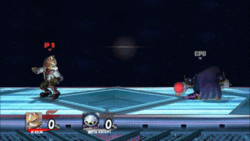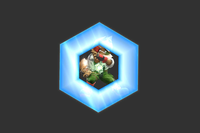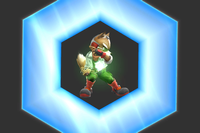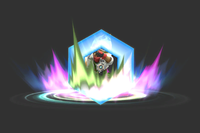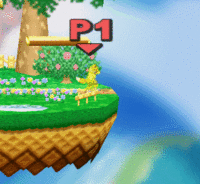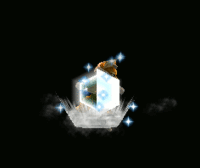| Welcome to SmashWiki! Log in or create an account and join the community, and don't forget to read this first! |
| Notices |
|---|
| The Skill parameter has been removed from Smasher infoboxes, and in its place are the new "Best historical ranking" and "Best tournament result" parameters. SmashWiki needs help adding these new parameters to Smasher infoboxes, refer to the guidelines here for what should be included in these new parameters. |
| When adding results to Smasher pages, include each tournament's entrant number in addition to the player's placement, and use the {{Trn}} template with the matching game specified. Please also fix old results on Smasher pages that do not abide to this standard. Refer to our Smasher article guidelines to see how results tables should be formatted. |
| Check out our project page for ongoing projects that SmashWiki needs help with. |
Reflector (Fox)
- For the other down special moves of the same name, see Reflector (Falco) and Reflector (Wolf).
| Reflector | |
|---|---|
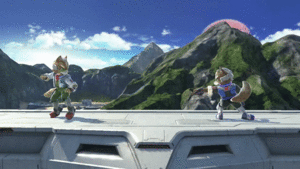 Fox's Reflector in Super Smash Bros. Ultimate. | |
| User | Fox |
| Universe | Star Fox |
Reflector (リフレクター, Reflector), informally known as Shine (primarily its Melee incarnation), is Fox's down special move. When used, Fox surrounds himself in a blue hexagonal energy field that reflects any projectile that touches it. It can also be used to damage enemies in close proximity to Fox when activated. If this shield deflects too many projectiles in one use, or if its user attempts to reflect a projectile of sufficient power (such as a constantly reflected Red or Green Shell), it will shatter, like a normal shield, and leave the user stunned. In Brawl, and later Smash games by extension, the Reflector does not shatter. Rather, the projectile will instead bypass it and hit Fox. It was revealed that the shield originates from a small device the user carries. How it is used and its effects depends on the user.
Overview[edit]
Fox's Reflector creates a blue hexagonal shield around himself. Any projectile that contacts the reflector will be reflected with a damage multiplier applied. Fox can keep the Reflector active for as long as he wants, and using it in midair slows his falling speed (this works by reducing his air speed and resetting his downwards acceleration).
In Super Smash Bros., the Reflector cannot be jumped out of, and is instead canceled instantly upon landing on the ground. Since the reflector cancels all momentum, it is quickest to immediately use the reflector after jumping; Fox will then instantly use the reflector and land-cancel the move. Additionally, while it will reflect most thrown items, it cannot reflect or protect against explosions. Aside from these two aspects, the Reflector is functionally the same as in Melee.
In Melee, Fox can also jump out of his reflector, like with regular shields, which is what allows waveshine combos. The reflector multiplies a projectile's damage and knockback by 1.5 when reflected. If the projectile is reflected several times, his reflector may break, similar to a shield breaking, though this is not the case in future installments, where the projectile just passes through the reflector and damages Fox normally. When used near a foe during its first few frames, it deals 6% damage with a slightly downward-angled horizontal angle (being a semi-spike), set knockback and a sparkling effect. The Reflector is often used for shine spikes in edgeguarding, which involve using the Reflector's damaging hitbox to knock recovering enemies downward. Due to the hitbox coming out instantly on frame 1, this makes it a very effective and unpredictable gimping tool. It is also extremely useful against bosses, considering as most of their attacks are projectiles. Fox's Reflector also grants him one frame of intangibility when used at the beginning; this was increased to four frames in Brawl.
In Super Smash Bros. and Super Smash Bros. Melee, the same Reflector sound is used. In Super Smash Bros. Brawl, the Reflector's sound effect was changed, and it was changed again in SSB4.
While the reflector is active, Fox's falling speed is altered: Fox falls and accelerates more slowly; this is the reason that the Chillin dash works. In Brawl, the move's ending lag was decreased, so Fox can effectively hover and stall in the air by repeatedly using his reflector. The slowed falling speed, mixed with the damaging aspect of the Reflector, can prevent Fox being juggled. Fox can also turn in midair when repeatedly activating the reflector. However, shine-spiking in Brawl is much less useful due to a combination of the reflector's damage affected knockback, slower startup, longer recoveries, and floatiness, though it can be used immediately while hanging on a ledge.
When Fox reflects a projectile on the ground from Brawl onward, he can cancel the move into a roll, spot dodge or jump by making the appropriate directional input during the reflector's animation change. As a result, when pulling out the reflector on the same frame that a projectile reaches it, it will almost always result in Fox spot dodge-canceling it, due to the player having to push down on the control stick to activate the move.
In Super Smash Bros. 4, Fox's Reflector was given much more ending lag, comparable to his Reflector in Melee, to prevent stalling in the air. It also no longer semi-spikes aerial opponents, practically eliminating all of the move's offensive capability in Fox's edgeguarding. Additionally, the move's startup lag has been doubled, and it no longer gives Fox intangibility on startup, limiting its use as a combo breaker.
In Super Smash Bros. Ultimate, the move's startup has been reverted to that of its Brawl iteration, and it once again grants Fox intangibility on startup during frames 2 and 3, improving its utility as a combo breaker or for shine spiking. However, it now only stalls Fox once in midair.
Instructional quotes[edit]
| Reflect projectile attacks back at enemies. | ||
| Reflect any projectiles back the way they came at great speed. | ||
| Reflect incoming projectiles and increase their power. | ||
| Shields and reflects projectiles, upping their speed and power. |
Customization[edit]
Special Move customization was added in Super Smash Bros. 4. These are the variations:
- Reflector: Default.
- Big Reflector: Increases the size of the reflector by a noticeable amount, decreases the damage multiplier on reflected projectiles (being only 1.2x), and gives it a push effect that sends opponents in the direction he faces instead of the ability to deal damage.
- Amplifying Reflector: Increases the damage multiplier on reflected projectiles by around 2.1x, but has no damage, no pushback, cannot stall in midair, and has increased startup frames. The reflection range is also smaller, barely covering Fox's body.
Big Reflector being used in Super Smash Bros. for Nintendo 3DS.
Amplifying Reflector being used in Super Smash Bros. for Nintendo 3DS.
Techniques[edit]
Chillin dashing[edit]
Fox can perform a technique referred to as Chillin dashing, named after Chillindude829, in Super Smash Bros. Melee. It is performed by running off the edge, and at the moment the character is going to fall off, the character must use the Reflector and perform a jump shine. Covering a decent distance, it is useful for edgeguarding. It is generally followed up by a jump canceled back aerial. A pseudo-Chillin dash can be performed in Super Smash Bros.; however, since Fox cannot jump out of his Reflector, it would only work to edgeguard against recoveries.
Shine dropping[edit]
Similar to shield platform dropping, this technique is done by activating Reflector while on a soft platform, and then dropping through it by pressing down on the control stick. This technique is the trigger to activate Shine Mines.
Shine mine[edit]
In Melee, Fox and Falco can perform a technique referred to as Shine Mining, a term coined and discovered by Darktooth. It is performed by first activating Reflector or powershielding in the location the player wishes to leave the shine mine. When placing a mine, there must also exist a projectile in play that could be reflected, until the player drops their Reflector or powershield. If powershield is used to place the mine, then the player must also interrupt their shield with something by the 3rd frame of their powershield. Then, when the player wishes to activate the mine, they must perform a shine drop through a platform anywhere on stage, and the mine will become an active reflector for exactly two frames starting from the 2nd frame after activation. It is important to note that the mine does not have the knockback and damage properties of the initial frames of a normal reflector - it can only reflect projectiles. The limited uses and difficult input timing make this technique extremely situational, but it can be used in various ways for edge-guarding.
Sometimes a player has a usable shine mine at match start, without having to do anything to place it.[1]The existence of this go mine depends on stage, the characters in game, and the port order of the controllers of those characters.
Shine grab[edit]
In Melee, Fox (along with Falco) can grab immediately out of a Reflector. This is possible because it is interruptible with a jump which from there the player can perform a jump-canceled grab. The resulting animation shows a Reflector immediately followed by a grab. This is useful because when performed on an opponent's shield, if the hitbox doesn't connect then the grab will due to the grab's property of beating shields. This technique isn't unbeatable however. A player can easily roll away before the grab is performed if a Shine grab is correctly predicted. This particular situation plays into the role of mindgames.
Waveshine[edit]
In Melee, Fox and Falco can repeatedly Wavedash, then activate Reflector while in the Wavedash. During this process, the player can quickly close gaps while being invincible to projectiles most of the time, and also stun the opponent with the up-close hitbox while pushing them forward, potentially resulting in an infinite with precise timing and positioning, especially on stages with walls like the fire transformation on Pokémon Stadium.
Multi shine[edit]
In Melee, Fox and Falco are capable of activating their Reflector multiple times in rapid succession. Also referred to as the Double shine, it involves a very precise and technically demanding process. The player must jump-cancel a Reflector and activate a second Reflector in a tight timing window. If done correctly, Fox or Falco will immediately land on the ground, which can allow them to jump-cancel the second Reflector, allowing the process to be repeated indefinitely. This technique is slightly easier to perform with Falco, as his jump squat animation is 2 frames longer than Fox, making the window to jump-cancel that much larger at the cost of performing the technique slower overall.
The Multi shine is an incredibly effective pressure tool, as it effectively keeps the Reflector hitbox active forever, with gaps that are too small for any normal player to react to depending on the character used. However, the Double shine is somewhat rare in tournaments, especially it being used more than twice in a row, as its required technical precision can lead to errors that could be easily punished.
Frame data[edit]
Note that frames given assume that inputs are given during the first frame of every range (i.e. all inputs are frame-perfect). It also assumes none of the shines hit (i.e. does not count freeze frames).
| Frame (Fox) | Frame (Falco) | |
|---|---|---|
| 1 | 1 | Reflector 1 |
| 4-21 | 4-21 | Jump window. Keeping the Reflector active extends the window indefinitely. |
| 7 | 9 | Reflector 2. If done later than this, Fox/Falco will jump too high for the technique to continue. |
| 10 | 12-13 | On these frames, the Reflector can be jump-cancelled, but Fox/Falco is still in the air. Jumping here will use a double jump and allow the next shine to come out on the next frame, but end the multishine cycle. |
| 11 | 14 | Beginning at this frame, Fox/Falco is grounded. |
| 12 | 15 | Earliest frame the jump can start. |
| 15 | 20 | Reflector 3. From here the technique loops to the point marked "Reflector 2". Therefore, Fox can perform this process every 8 frames while Falco takes 11 frames. |
Origin[edit]
Like most of Fox's moves, the Reflector is unique to the Super Smash Bros. series, but may have been inspired by the Arwing's ability to deflect enemy fire by doing a Barrel Roll. The Barrel Roll may also be referenced by Fox's ability to cancel the Reflector with a roll when successfully reflecting a projectile, starting in Brawl.
As revealed in Brawl, Slippy is the Reflector's original designer, and provided Fox and Falco with this special equipment for the occasion of fighting. Fox's energy shield shape as a hexagon might also reference the shape of the Supply rings in Star Fox 64. Unlike the hexagon shape in Super Smash Bros., the Supply Rings in the Star Fox games were only silver and gold colored, never being a light blue color. Up until Brawl, there was no sign of how Fox activated his Reflectors, as he simply held a stance and the energy shield simply "appeared" around them. However, Subspace Emissary and the Star Fox cast's redesigns in Brawl revealed that their reflectors were miniature devices that activated on a swipe of their hands. These devices would later make their first canonical appearance in Star Fox Zero, once again attached to Fox and Falco's belts but serving no purpose in gameplay.
Gallery[edit]
Fox's Reflector in Super Smash Bros. for Nintendo 3DS.
Fox preparing to reflect Samus' Charge Shot.
Fox using Reflector as shown by the Move List in Ultimate.
Names in other languages[edit]
Trivia[edit]
- In Super Smash Bros., level 5 and higher CPUs will never use the Fire Flower or Ray Gun against Fox, since he can reflect the projectiles. Instead, they will just throw the item at him, even though he can still reflect the thrown item.
- In Super Smash Bros. Melee, CPU Foxes at high levels mostly use their down throw when grabbing someone, and then quickly follow up with a shine to push the enemy sideways. As CPUs in Melee use grabs as one of their main attacks, this combo easily becomes exploitable by them. It can be easily avoided, however, as the last hit can be instantly teched since it drops the foe on the ground. The tech even allows to avoid the shine without rolling away.
- Also, if the CPU Fox uses another type of throw and the foe is left close to it (such as by low damage ratio), it may use the Reflector even if it doesn't reach the foe.
- In Super Smash Bros., if Fox uses Reflector on a walking Bob-omb, the Bob-omb will one-hit KO anyone who touches it.
- From Brawl onwards, Fox is shown using a hexagonal device to activate his reflector, a trait shared with Falco and Wolf. Ingame, it hovers in front of him while in use. A Subspace Emissary cutscene shows Fox activating the device by waving his hand in front of it, which is not the case for the actual move.
- In Smash 4 and Ultimate, there's a glitch where if Fox turns around on the first possible frame and back on the very next frame while activating his Reflector, there will be no graphical effects along with the Reflector being silent until he reflects an incoming projectile or sometimes if repeatedly turning.
- The term Shine was reportedly coined by Matt Deezie, who had a habit of wearing a highly reflective sequin shirt during tournaments. He frequently used the term during his Tournament Go series, where it spread to online forums like SmashBoards and has stuck as a slang term to this day.
Technical details[edit]
- Fox (SSB)/Down special
- Fox (SSBM)/Down special
- Fox (SSBB)/Down special
- Fox (SSB4)/Down special
- Fox (SSBU)/Down special
